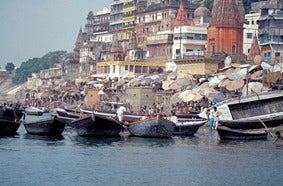 Historically, cities and civilizations have flourished along water bodies, which not only served as important transportation corridors to spur economic activity and trade, but also as prominent public spaces for religious and cultural interaction. Today, while a large number of cities have turned away from this important natural resource, many have reclaimed and transformed their waterfronts into thriving economic engines and nodes of social activity. Can cities redefine their relationship with water while managing challenges of rapid urbanization?
Historically, cities and civilizations have flourished along water bodies, which not only served as important transportation corridors to spur economic activity and trade, but also as prominent public spaces for religious and cultural interaction. Today, while a large number of cities have turned away from this important natural resource, many have reclaimed and transformed their waterfronts into thriving economic engines and nodes of social activity. Can cities redefine their relationship with water while managing challenges of rapid urbanization?
The World Bank’s South Asia Sustainable Development Unit, in collaboration with East Asia Pacific Sustainable Development Unit, is organizing a webinar on waterfront development to discuss different dimensions of waterfront initiatives and tools for a sustainable regenerative economic environment.
Join our webinar with experts including:
- Peter Ellis, The World Bank
- Richard Marshall, Perkins+Will
- Victor Vergara, The World Bank
- Michael Grove, Sasaki Associates
- Bonnie A. Harken, Nautilus International Development Consulting Inc.
Date: Thursday, Jan. 10, 2013
Time: 9 to 10:30 a.m. EST
Place: Online via Adobe Connect: http://worldbankva.adobeconnect.com/urbanization-waterfront/

Focusing on waterfronts in urbanization debates is imperative as, according to U.N. HABITAT, "Global average density along coastlines is 1,100 inhabitants per square kilometer, compared to 500 inhabitants per square kilometer in dry lands and 700 inhabitants per square kilometer in cultivated areas." Such population concentration provides opportunities for growth and social transformation.
This webinar on waterfront development will cover global perspectives on transforming waterfronts into assets while balancing social and environmental needs, and case studies on cities that have used institutional restructuring, financing mechanisms, and spatial planning to mitigate risks associated with boom and bust cycles, and climate change. The presentations will be followed by a question-and-answer session.
The event is open to urban practitioners in the public and private sectors. We welcome your participation in this webinar session to share, generate, and innovate best practices to shape our sustainable urban future. This webinar is a timely opportunity to engage and facilitate a dialogue between practitioners and policymakers from within and outside the region, and to learn from successful and effective initiatives across the globe. We hope that the webinar series will lead to stimulating discussions and knowledge exchange to inform the World Bank’s Urbanization Flagship Projects.
Click here to learn more about the detailed agenda and login instructions for the webinar.


Join the Conversation